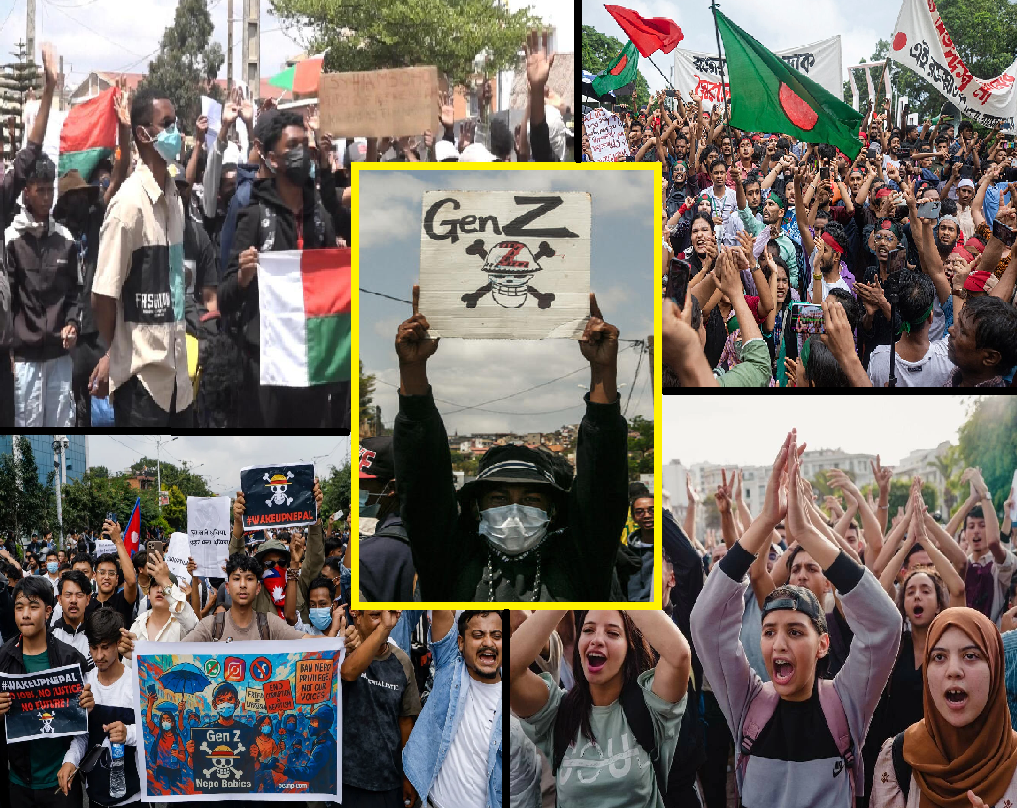
- Over the last year, Gen Z-led protests have successfully challenged governments. Notably, one in Bangladesh, where the so-called student protests dethroned Sheikh Hasina and the protests in Nepal that led to the fall of the Communist government.
- In Morocco, protesters have made it clear that they do not want the FIFA World Cup; they want their lives to improve as the country’s economy has stagnated, with unemployment rates soaring.
- In Madagascar, the government has blamed external forces for trying to destabilise and exploit its critical minerals, while Gen Z protesters have dismissed these claims as baseless.
- The current wave of protests serves as a lesson for governments to be transparent, accountable, and responsive to their citizens, and to prevent any external interference that could manipulate public sentiment and fuel instability within their nations.
From Rabat to Manila, from Madagascar to Peru, countries across the world have been witnessing a new surge of protests, supposedly led by Gen Z. This same generation, once regarded as the driver of economic growth both domestically and globally, is now being manipulated to take to the streets. Over the last year, Gen Z-led protests have successfully challenged governments. Notably, two of these uprisings occurred in South Asia, one in Bangladesh, where the so-called student protest rose against former Prime Minister Sheikh Hasina and dethroned her from power. Although it appeared to be a student-led protest, in reality, it was a politically motivated external campaign against her.
A month ago, a Gen Z protest successfully toppled the communist regime in Nepal. The success of these Gen Z protests in that part of the world has reignited similar movements, particularly in Africa, one in North Africa and another in the southern part of the continent. Both protests are fueled by Gen Z, and interestingly, their reasons are quite similar.
Protest in Morocco
In Morocco, a country in North Africa, the protest closely resembles the decade-old Arab Spring that began in Tunisia and spread across the Arabian Peninsula, successfully toppling various governments. The Gen Z protests led by young people have raised alarm bells among those in power, particularly in Morocco. The protest, which began a week ago by a group called ‘Gen Z 212’, has a strong presence on Discord. They came onto the streets to protest against the high expenditure by the Moroccan government for the preparation of the 2030 FIFA World Cup.
A large number of people have joined the protests, stating that they oppose excessive spending on sports or stadium renovations. Instead, they are demanding better public services, more employment opportunities, and overall improvement in their quality of life. Protesters have made it clear that they do not want the FIFA World Cup; they want their lives to improve.
Morocco’s economy has recently stagnated, with unemployment rates soaring. Among Gen Z, 35.8% are unemployed, meaning more than one in three people under 25 years of age are jobless. One out of every five undergraduates in Morocco remains unemployed. Protesters have taken to the streets, and the government, led by Aziz Akhannouch, has called these demonstrations an attempt to topple the regime. The Prime Minister has accused domestic and external opposition forces of using Gen Z to create instability in the country. In the last week alone, the protests have turned violent, killing four people and bringing major cities like Rabat and Casablanca to a standstill.
The Madagascar Protest
In the same continent, but thousands of kilometres south, lies the poor African island nation of Madagascar. The country faces severe unemployment, a lack of opportunities, and a growing sense among the youth that the only way to survive is to leave the country. As a result, Gen Z protesters have come out against the regime led by Andry Rajoelina, protesting against constant power cuts and water shortages that have crippled daily life.
Citizens state that the government has failed not only to provide jobs and opportunities but also to ensure basic necessities such as water and electricity. These protests have turned violent, and in the last week, 22 people have been killed and hundreds injured. The government has blamed external forces for trying to destabilise Madagascar and exploit its critical minerals, while Gen Z protesters have dismissed these claims as baseless.
Similar protests have emerged in Peru and the Philippines, fueled by frustration over government corruption and unmet promises.
Protest in Peru & Philippines
In Latin America, Peru has also been witnessing protests, and this time the actors leading the movement are again the Gen Z. The youth are protesting against the new pension system recently introduced in the country, which allows all individuals above the age of 18 to join the pension provider. However, the protest is also directed against the government headed by Dina Boluarte, as people accuse the administration of ongoing corruption and failure to fulfil the aspirations of the citizens. As the protests continue, Dina Boluarte’s public approval rating stands at just around 2.5%. These ongoing protests in Peru are part of a series of demonstrations that have been taking place since 2022, when the then-president, Pedro Castillo of Peru, was removed and arrested.
Similar protests have also been ongoing in the Philippines, where the people, especially Gen Z, have taken to the streets, accusing President Bongbong Marcos Jr.’s government of corruption. The protests are particularly centred on allegations of misuse of flood relief funds that were meant to aid victims of the recent floods. The Philippines is also facing growing political challenges, as Marcos Jr. has been accused of adopting dictatorial tendencies and sidelining the opposition. People in the Philippines have held Marcos Jr. responsible for rising corruption, drawing comparisons to former President Rodrigo Duterte. This has intensified the crisis, drawing both Gen Z and opposition groups into the protests.
Are Gen Z Protests Organic?
The question that arises now is whether the motivations behind these Gen Z protests are genuinely organic or are they externally influenced. There is no doubt that a growing sense of unity among youth is emerging worldwide. The recent success of Gen Z movements in Nepal and Bangladesh has reignited the spirit of protest, encouraging youth elsewhere to question their governments.
However, it is also important to recognise that not every protest is entirely spontaneous. In many instances, Gen Z has become a convenient tool for external actors to create instability. Using social media and youth activism, such movements appear spontaneous and democratic, but they can sometimes conceal hidden agendas.
History proves that popular protests, whether led by Gen Z or others, have not always resulted in long-term stability. The Arab Spring provides a prominent example. Though it began as a movement to overthrow authoritarian rulers, it ultimately left many countries in chaos. Nations like Libya, Iraq, and Syria became epicentres of instability, radicalisation, and terrorism. The promised hope of freedom and prosperity never materialised.
Bangladesh also provides a relevant example. Under Sheikh Hasina, the country was considered a developing economy with rising purchasing power and emerging manufacturing potential. However, within a year of her ouster, the country fell into economic hardship, unemployment, and instability.
Therefore, while Gen Z-led protests may appear organic and genuine, they must also be viewed through the lens of pragmatism. The current wave of protests serves as a lesson for governments to be transparent, accountable, and responsive to their citizens, and to prevent any external interference that could manipulate public sentiment and fuel instability within their nations.
References:
- https://www.business-standard.com/world-news/gen-z-anger-at-ruling-elites-fuels-protests-in-countries-across-the-world-125100400341_1.html
- https://www.newindianexpress.com/world/2025/Oct/04/rival-rallies-due-in-madagascar-after-deadly-gen-z-protests
- https://www.dw.com/en/moroccos-gen-z-protests-what-you-need-to-know/a-74220115
- https://www.thehindu.com/news/international/at-least-19-injured-in-peru-anti-government-protests/article70107667.ece
Aayush Pal is a freelance writer on contemporary geopolitical developments. The views expressed in his work are entirely his own.
